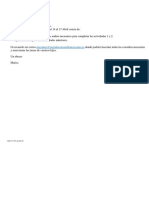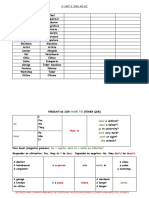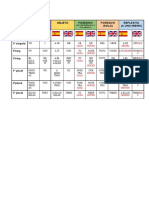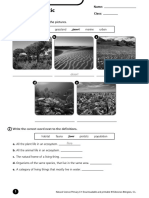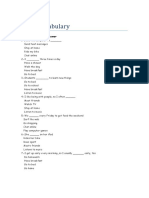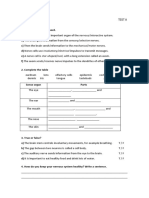0 ratings0% found this document useful (0 votes)
45 viewsUnit 4 Population
Unit 4 Population
Uploaded by
Adriana Ainhoa Loor castilloThe document discusses population and demography, including factors that affect population such as birth rates, death rates, immigration, and emigration. It also discusses how population is measured through censuses and surveys and describes population density. Specific details about Spain's population include that it increased steadily in the 20th century, most Spaniards live in urban areas, and migration trends have impacted the population.
Copyright:
© All Rights Reserved
Available Formats
Download as PDF, TXT or read online from Scribd
Unit 4 Population
Unit 4 Population
Uploaded by
Adriana Ainhoa Loor castillo0 ratings0% found this document useful (0 votes)
45 views2 pagesThe document discusses population and demography, including factors that affect population such as birth rates, death rates, immigration, and emigration. It also discusses how population is measured through censuses and surveys and describes population density. Specific details about Spain's population include that it increased steadily in the 20th century, most Spaniards live in urban areas, and migration trends have impacted the population.
Copyright
© © All Rights Reserved
Available Formats
PDF, TXT or read online from Scribd
Share this document
Did you find this document useful?
Is this content inappropriate?
The document discusses population and demography, including factors that affect population such as birth rates, death rates, immigration, and emigration. It also discusses how population is measured through censuses and surveys and describes population density. Specific details about Spain's population include that it increased steadily in the 20th century, most Spaniards live in urban areas, and migration trends have impacted the population.
Copyright:
© All Rights Reserved
Available Formats
Download as PDF, TXT or read online from Scribd
Download as pdf or txt
0 ratings0% found this document useful (0 votes)
45 views2 pagesUnit 4 Population
Unit 4 Population
Uploaded by
Adriana Ainhoa Loor castilloThe document discusses population and demography, including factors that affect population such as birth rates, death rates, immigration, and emigration. It also discusses how population is measured through censuses and surveys and describes population density. Specific details about Spain's population include that it increased steadily in the 20th century, most Spaniards live in urban areas, and migration trends have impacted the population.
Copyright:
© All Rights Reserved
Available Formats
Download as PDF, TXT or read online from Scribd
Download as pdf or txt
You are on page 1of 2
UNIT 4: POPULATION
A changing population
Demography is the study of human populations. It is affected by birth rates
(tasa de natalidad), death rates (tasa de mortalidad), immigration (inmigración)
and emigration (emigración).
Absolute population (población total) of an area is the total number of
inhabitants in a place or country. To calculate the absolute population, we need:
Census (censo) is a collection of data to calculate population changes. The data
is collected by surveying (sondeos, encuestas…).
Population density describes (describe) the number of people in an area.
Factors affecting population density
● Natural causes: floods (inundaciones), earthquakes (terremotos) and
droughts (sequía).
● Social causes: hunger (hambruna) and poverty (pobreza)
● Political causes: wars (guerras)
● Economic causes: Job opportunities and better wages (mejor salario).
Characteristics of the population of Spain
The population of Spain increased steadily (continuamente) during the 20th
century.
The distribution of the Spanish population
Spain has a population density of 93 inhabitants per square kilometer. Majority
of Spanish inhabitants (mayoría de la población) live in urban areas.
Migration trends in Spain
You might also like
- Unit 5 Year 4 Our HeroesDocument8 pagesUnit 5 Year 4 Our HeroesJ4FNo ratings yet
- Social Science 5º - Unit 6Document5 pagesSocial Science 5º - Unit 6Carlos Suárez RuizNo ratings yet
- Unit 1. PopulationDocument1 pageUnit 1. PopulationJosé María Nogueras Valdivieso100% (1)
- The Units of Living ThingsDocument2 pagesThe Units of Living ThingsAnonymous he4hP6Y06CNo ratings yet
- Sociales 4Document2 pagesSociales 4Sese Martínez ColmenarNo ratings yet
- Examen Science 4 - School Community - Libro Viejo - Unit 9 - Science 4Document4 pagesExamen Science 4 - School Community - Libro Viejo - Unit 9 - Science 41noone1100% (1)
- UNIT 5. Spain in The HistoryDocument6 pagesUNIT 5. Spain in The HistoryJosé María Nogueras ValdiviesoNo ratings yet
- Present&Past Simple, Present ContinuousDocument3 pagesPresent&Past Simple, Present Continuousdedy0% (1)
- English. Standard Test. Unit 5. 14 17 AbrilDocument7 pagesEnglish. Standard Test. Unit 5. 14 17 AbrilAna Maria RoldanNo ratings yet
- 9d92f Naturalscience06 Unit04 Test Solutions PDFDocument1 page9d92f Naturalscience06 Unit04 Test Solutions PDFCarlos Calleja PeñaNo ratings yet
- History 3º Primaria OxfordDocument12 pagesHistory 3º Primaria OxfordPatricia100% (2)
- 3º High Five Tema 6Document3 pages3º High Five Tema 6ElenaArevalo0% (1)
- Social Science Unit 5 Prehistory TestDocument2 pagesSocial Science Unit 5 Prehistory TestEva Rico100% (2)
- Examen Science Tema 3Document8 pagesExamen Science Tema 3Mai VallejoNo ratings yet
- GMF L6 Units 1-9 Standard Level Tests Answer KeyDocument18 pagesGMF L6 Units 1-9 Standard Level Tests Answer KeyThuNo ratings yet
- Name: Class: End-Of-Unit TestDocument2 pagesName: Class: End-Of-Unit TestJose Manuel AlcantaraNo ratings yet
- GMF L6 Units 1-9 Standard Level TestsDocument36 pagesGMF L6 Units 1-9 Standard Level TestsThuNo ratings yet
- Natural Sciences Exam - Unit 4 "Our Systems" NameDocument3 pagesNatural Sciences Exam - Unit 4 "Our Systems" NameSilvia IzquierdoNo ratings yet
- Relatives ClausesDocument2 pagesRelatives Clausesbenilde bastidaNo ratings yet
- 5º Nervous Locomomotor Systems by MEDocument3 pages5º Nervous Locomomotor Systems by MEElenaArevaloNo ratings yet
- 05.end of Unit Test U4Document2 pages05.end of Unit Test U4Jose Manuel AlcantaraNo ratings yet
- Student's Booklet: Spain in The 19th CenturyDocument13 pagesStudent's Booklet: Spain in The 19th CenturyrafakarmonaNo ratings yet
- 4º UNIT 8 High FiveDocument2 pages4º UNIT 8 High FivemariasanztiNo ratings yet
- Diagnostic Test Name: Class:: Unit 3Document1 pageDiagnostic Test Name: Class:: Unit 3Jose Manuel AlcantaraNo ratings yet
- Natural Science 5 Unit1 Forms of LifeDocument17 pagesNatural Science 5 Unit1 Forms of LifeMariaDoloresMuñozBaños100% (1)
- Used To 2Document3 pagesUsed To 2Sylvia RodríguezNo ratings yet
- Sujeto Objeto Posesivo Posesivo (SOLO) Reflexivo (A Uno Mismo)Document1 pageSujeto Objeto Posesivo Posesivo (SOLO) Reflexivo (A Uno Mismo)Cosmic KatharsisNo ratings yet
- Unit 5 People Around UsDocument5 pagesUnit 5 People Around UsDéboraNo ratings yet
- Mouth Intestine Stomach Esophagus: 1. Write The Parts of The DIGESTIVE SYSTEMDocument1 pageMouth Intestine Stomach Esophagus: 1. Write The Parts of The DIGESTIVE SYSTEM341389.No ratings yet
- Primary HF6 Unit - 2 - ExamDocument7 pagesPrimary HF6 Unit - 2 - Exambenilde bastidaNo ratings yet
- Activity Book: Primary 5Document9 pagesActivity Book: Primary 5Raquel ColladoNo ratings yet
- Social ScienceDocument8 pagesSocial ScienceAn Mon teNo ratings yet
- 45e51-Naturalscience04 Unit06 DiagnosticDocument2 pages45e51-Naturalscience04 Unit06 DiagnosticJose Manuel AlcantaraNo ratings yet
- Unit2 Examen Tipo TestDocument6 pagesUnit2 Examen Tipo Testbenilde bastidaNo ratings yet
- Unit 9 MachinesDocument8 pagesUnit 9 MachinesCristina GomezNo ratings yet
- 6 Worksheet 6.1Document2 pages6 Worksheet 6.1Irene Moreno CastrilloNo ratings yet
- Material de Refuerzo y Recuperación 1 EvaluaciónDocument14 pagesMaterial de Refuerzo y Recuperación 1 EvaluaciónsouleandoythNo ratings yet
- Activity 3 - Check Your ProgressDocument1 pageActivity 3 - Check Your ProgressCristina LlorenteNo ratings yet
- Write The Part of The PlantsDocument3 pagesWrite The Part of The PlantsAlvaro Ruano PerezNo ratings yet
- HF6 ReviewWorksheets AnswerKeyDocument4 pagesHF6 ReviewWorksheets AnswerKeymarisagoncalvesNo ratings yet
- Test U4Document2 pagesTest U4Fernando OssNo ratings yet
- Examen ScienceDocument4 pagesExamen ScienceCENSONo ratings yet
- Faster: Unit 2Document4 pagesFaster: Unit 2noeliaNo ratings yet
- Examen Reading B2 Con SolucionesDocument6 pagesExamen Reading B2 Con SolucionesigmarbarNo ratings yet
- Ace 1 - Syllabus PDFDocument1 pageAce 1 - Syllabus PDFMarina Fernández MelgarNo ratings yet
- Choose The Right Modal To Complete The F. SentencesDocument3 pagesChoose The Right Modal To Complete The F. Sentencesbenilde bastidaNo ratings yet
- ByME Natural Science 3 Summary UnitsDocument6 pagesByME Natural Science 3 Summary UnitsElenaArevaloNo ratings yet
- Test Unit 5 - Matter and Heat - 3º PrimariaDocument2 pagesTest Unit 5 - Matter and Heat - 3º Primarialaura_arribas93No ratings yet
- KB BE L5 - U5 - TestDocument1 pageKB BE L5 - U5 - TestMoeNo ratings yet
- Test 7 Ace 4Document3 pagesTest 7 Ace 4Belén Alcaine MiguelNo ratings yet
- Vocabulary U 06Document1 pageVocabulary U 06MarieNo ratings yet
- NS6 M1 U01 Test ADocument2 pagesNS6 M1 U01 Test ACristina Araque Díaz de los BernardosNo ratings yet
- Science 2º Primaria Tema 1Document8 pagesScience 2º Primaria Tema 1CarmenMariaGuijoNo ratings yet
- 4 Population 5º Primaria Social ScienceDocument21 pages4 Population 5º Primaria Social SciencevicmasterepubNo ratings yet
- Presentation 3Document18 pagesPresentation 3Martina Rovira RodríguezNo ratings yet
- Population Density and StructureDocument3 pagesPopulation Density and Structuremaria.sempere09No ratings yet
- THE DEMOGRAPHIC WPS OfficeDocument26 pagesTHE DEMOGRAPHIC WPS OfficeRjay AgdonNo ratings yet
- PPL N Earth 1Document8 pagesPPL N Earth 1Ferzayra DawiliNo ratings yet
- Chapter 10 GROUP 5Document17 pagesChapter 10 GROUP 5marksimbajon2004No ratings yet
- Module 4, Lesson 1 MigrationDocument32 pagesModule 4, Lesson 1 MigrationMcdiery ConcepcionNo ratings yet








